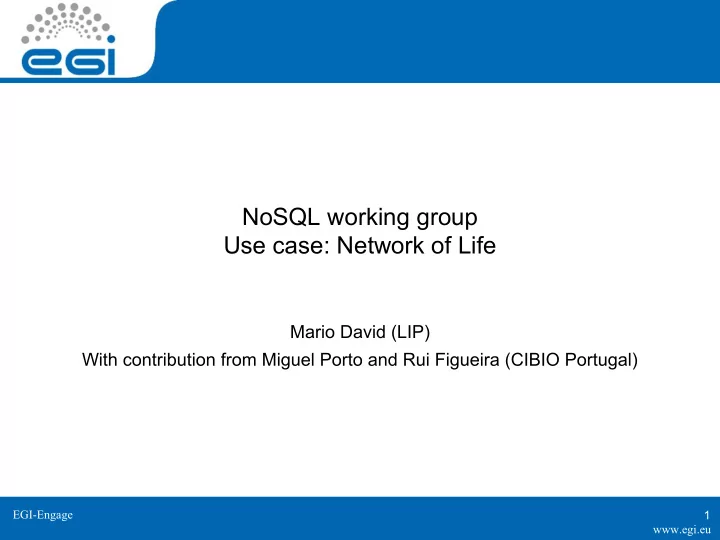

NoSQL working group Use case: Network of Life Mario David (LIP) With contribution from Miguel Porto and Rui Figueira (CIBIO Portugal) EGI-Engage 1 www.egi.eu
Outline • GBIF and Atlas of Living Australia Web portal • From GBIF to Network of Life • Graph DBs - ArangoDB • Current status and first tests EGI-Engage 2 www.egi.eu
Challenges of GBIF biodiversity data Global Biodiversity Information Facility • 570 million records with many dimensions. • Need to support different spatial scales, information detail, in the same platform. • Ensure confidence, users need to be able to scrutinize all details of information. • The rate of new data addition is not fully predictable. • Crossing data with other types of information (remote sensing, climatic) is also resource-demanding. EGI-Engage Rui Figueira (CIBIO) 3 www.egi.eu
Atlas of Living Australia Platform for web portals and services for societal uses in biodiversity Provide: • Efficient organization and management of biodiversity information, including to find, access and visualize data; • Integration with genetic, habitat, ecosystem and geographical data; • Building different facets, e.g., for Invasive Alien Species, threatened species, nature conservation • Web data services through API. EGI-Engage Rui Figueira (CIBIO) 4 www.egi.eu
One platform, many facets (thematic, regional, national), different user communities EGI-Engage Rui Figueira (CIBIO) 5 www.egi.eu
One platform, many facets (thematic, regional, national), different user communities EGI-Engage Rui Figueira (CIBIO) 6 www.egi.eu
One platform, many facets (thematic, regional, national), different user communities EGI-Engage Rui Figueira (CIBIO) 7 www.egi.eu
One platform, many facets (thematic, regional, national), different user communities EGI-Engage Rui Figueira (CIBIO) 8 www.egi.eu
One platform, many facets (thematic, regional, national), different user communities EGI-Engage Rui Figueira (CIBIO) 9 www.egi.eu
Advantages of cloud solutions Provide: • Scalability of the allocation of resources. • Sharing infrastructure and capacity between members of GBIF network. • Persistence and availability of big volumes of data. EGI-Engage Rui Figueira (CIBIO) 10 www.egi.eu
GBIF ⇒ Net of Life Biologists POV GBIF { { --- --- --- --- --- --- --- --- } } EGI-Engage 11 www.egi.eu
GBIF ⇒ Net of Life Biologists POV Network of Life pollination { --- --- --- { { --- --- --- } --- --- --- --- --- --- } } EGI-Engage 12 www.egi.eu
GBIF ⇒ Net of Life Maths/Comp.Scient POV G = (V, E) V = {v1, v2, …} Graph ⇒ GraphDB E = { {v1, v2}, {v1, v3},... } Vertices Edges EGI-Engage 13 www.egi.eu
GBIF ⇒ Net of Life Maths/Comp.Scient POV GraphDB + Documents ⇒ ArangoDB Vertices Edges { --- --- --- { { --- --- --- } --- --- --- --- --- --- } } Documents EGI-Engage 14 www.egi.eu
ArangoDB - I • Multi-model database: document, graph, key-value • Open source: https://github.com/arangodb/arangodb • Document model : • Data stored as linked JSON-like documents, organized in collections • No schema enforced, but set of indexes can be defined for each collection • Fields can store other subdocuments and pointers to independent documents EGI-Engage Miguel Porto (CIBIO) 15 www.egi.eu
ArangoDB - II • Graph model : • An “interpretation” built upon the document model: • Defined by a set of document collections representing vertices . • Another set of collections representing the edges connecting the vertices. • Vertexes and Edges are documents. • Native support for traversal queries: • Highly customizable behaviour • No need for “infinite” JOINs. • Indexes : • Graph traversal indexes (edge-vertex connections) • Geo indexes (constructed from latitude-longitude fields) • Full text, hash, etc. EGI-Engage Miguel Porto (CIBIO) 16 www.egi.eu
ArangoDB - III • AQL query language : • SQL-like but very different logic: • Entirely JSON-based. • No tables. • Rather complete set of functions to work with documents: • Data aggregation. • Filtering (including Geo functions), etc. • Document and array manipulation • Graph traversal and shortest path functions • Easy querying, processing and output results in the desired data format • Very flexible in chaining and nesting query sentences “Powerful and Fast” EGI-Engage Miguel Porto (CIBIO) 17 www.egi.eu
Network of Life: Architecture Parallelized computations Data analysis native modules JSON data WEB services AQL queries Network of Life Frontends, Web, ArangoDB server Java server R Graph traversal Exposes services for: Visualization Data aggregation ● querying interaction data at different Network queries levels of aggregation Network data analysis ● downloading raw data Hypothesis testing ● submitting data analysis jobs Data downloading ● uploading new data ... EGI-Engage Miguel Porto (CIBIO) 18 www.egi.eu
Some first tests • Simple ArangoDB instance running on the desktop • Good query performance, in particular the ones involving geographic indexes and graph traversal • ArangoDB having integrated geo indexes matches nicely the use case • The application logic should be implemented in the AQL queries. EGI-Engage Miguel Porto (CIBIO) 19 www.egi.eu
Test deployment • ArangoDB in cluster mode ⇒ allow sharding • Deployed 2 VMs in INCD Openstack • Each VM with 2 types of processes: • Coordinators : receives requests, distributes them to the DBServers, executes AQL queries and returns the result to the clients. The coordinator also exposes information about cluster health and cluster statistics. • DBServers : can both store sharded (and non-sharded) collections. • A database and a coordinator can live on the same server. • And… learning the business :) EGI-Engage 20 www.egi.eu
Recommend
More recommend